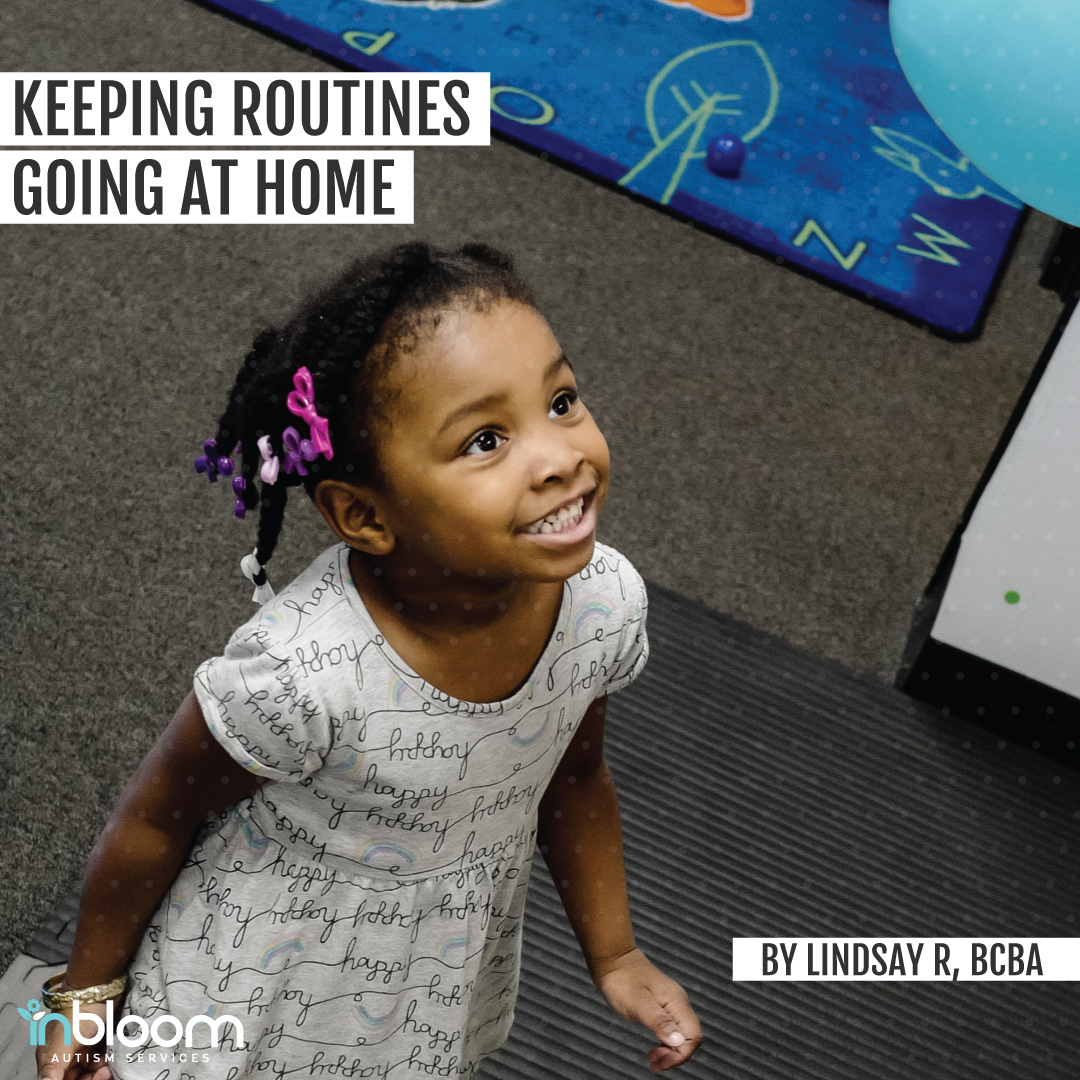KEEPING ROUTINES GOING AT HOME

WHY ARE ROUTINES IMPORTANT FOR CHILDREN WITH AUTISM?
Routines are helpful for all of us. They help us maintain consistency in our lives and provide us with a sense of comfort and security. We know what’s going to happen, when it’s going to happen, and why it’s happening. Recent research even shows that we can all benefit from having a routine and a regular rhythm in our lives (Lieber, 2018). Routine is especially important, however, for individuals with Autism Spectrum Disorder (ASD) (“Why Routine Is Important to Children with Autism Spectrum Disorder”, 2018). Here are a few reasons why:
- For many children with ASD, communication difficulties can make it hard for them to understand what’s happening around them, which can be stressful (“Obsessive behavior, routine and rituals: autism spectrum disorder”, 2020). Thus, having a routine helps them cope with stress and anxiety by creating allowing them to feel more in control of their environment and to create order and structure in their lives. Maintaining a routine allows individuals with ASD to learn what to expect and when to expect it. Routine helps create a safe environment that can otherwise seem unpredictable.
- Routine comes naturally for children with ASD. Individuals with autism often thrive off of repetition, so it’s typically not too difficult for them to learn and implement a daily routine that allows them to be more productive and successful.
- Routines assist with the learning process. Once a child has implemented a routine that feels good to them, they feel less stressed and are able to more effectively learn new things. They are better able to focus on developing new skills, achieving new accomplishments, and becoming more independent.
Routines are helpful for all of us. They help us maintain consistency in our lives and provide us with a sense of comfort and security.
HOW CAN WE MAINTAIN ROUTINES & STRUCTURE DESPITE THE CURRENT DISRUPTIONS?
During this time of increased uncertainty and chaos, maintaining structure for ourselves and our children is more important than ever. Without school, work, and many regularly scheduled activities, life as we (and our children) know it is “on hold.” So, the famous question is: “How can we maintain routines and structure during a time like this?!” Well, here are a few suggestions that are easy to implement, but will likely make a big, positive difference for you and your child:
Maintain a consistent sleep schedule.
Even though our kiddos aren’t going to school for the next few months, it’s really important to keep them on a consistent sleep schedule. They should go to sleep and wake up at similar times each night and day. If their internal clock is thrown off by having an inconsistent sleep schedule, things such as irritability, drowsiness, mood swings, difficulty focusing and concentrating, and a decline in cognitive skills can occur (Som, 2018).
Maintain consistent mealtimes.
Your child’s body and brain will function best if they’re kept on a consistent eating schedule (it may even be helpful to mimic the schedule they follow at school to ease the transition once school starts again).
The utilization of visual schedules and timers are often very helpful for children with autism.
Set a schedule that mimics a school day.
Structure your child’s day to include focused time on different subjects and activities, interspersed with breaks and play time. Also remember: each day does not have to be identical. Your child is used to “specials” at school, such as gym, art, music, etc. Incorporate one of those “specials” into each day in order to mix things up a bit and keep your child engaged. Some ideas include: riding a bike outside (gym), playing catch (gym), painting (art), making clay figurines (art), playing freeze dance (music), etc.
Utilize visual and auditory reminders throughout the day.
The utilization of visual schedules and timers are often very helpful for children with autism. Timers help your child know how long an activity will last and when an activity is about to end. You can use a visual timer (pictured below) or the timer on your phone. Additionally, a verbal warning often helps (e.g., “2 more minutes of play time and then we’re taking a bath!”). Some examples of visual schedules are also pictured below. Visual schedules allow your child to see what will be happening that day. Often, for our kiddos, visuals help with comprehension and understanding.
Visual Timer (the red area decreases as time passes)
A Visual Schedule
A Visual Schedule with Check Marks
Go on virtual outings.
Since “field trips” and outings are currently limited, you and your child can go on virtual outings instead! Some places, such as various museums and zoos, offer online experiences. Your child will be able to tour their spaces, as well as learn new things about their favorite subjects. This can also be a helpful way to prepare your child for in-person trips when school is back in session.
SAMPLE DAILY SCHEDULE
- By 9am: Out of bed, eat breakfast, get dressed, brush teeth/hair, make bed, complete other routine “before school” chores
- 9am–9:45am: Review schedule for the day, and get moving with a physical activity such as a walk outside, stretching, or a dance party inside
- 9:45am–10:45am: Focused academic time
- 10:45am–11am: Transition break: Quick game of tag, Simon Says, Frisbee, walk the dog
- 11am–11:30am: Lunch time
- 11:30am–12:30pm: Creative time: Build, draw, paint, create
- 12:30pm–1:30pm: Focused academic time
- 1:30pm–2:30pm: Quiet fun time. Look at books, watch iPad (limit time), color, build with Legos, dress up dolls, etc.
- 2:30pm–3pm: Outdoor play time: Bike ride, wagon ride, walk around the block, etc.
- 3pm–6pm: ABA Therapy
- 6pm–6:30pm: Quiet fun time. Look at books, watch iPad (limit time), color, build with Legos, dress up dolls, etc.
- 6:30pm–7:30pm: Dinner preparation, eating, and clean up
- 7:30pm–9pm: TV time, baths/showers, bedtime routine
- 9pm: Bed time
If you’re seeing family members during this time, don’t be afraid to ask them to come over and spend time with the kids. Your kiddos will love this, and it’ll give you some time to accomplish your own tasks.
HOW CAN WE MAINTAIN ROUTINES & STRUCTURE FOR OURSELVES
DESPITE THE CURRENT DISRUPTIONS?
All of this sounds great, right? But you might be wondering how in the world you’ll be able to implement and follow a consistent routine for your child, while still accomplishing all of your own personal tasks. Well, here are some tips on how to find that happy balance:
Wake up early.
Some parents rely on getting up before their kids are up, and feel that it’s the best time to get work done that requires 100% of their focus. Then, when the kids wake up and throughout the day, they fit in tasks that require less focus, such as calls or emails.
Set up snack and drink stations.
Prepare a bunch of snacks the night before and put them on a shelf that is easily accessible to you. That way, when your children are hungry, you can grab the already-made snacks and hand them to your kids, instead of having to take the time to choose and prepare the snacks in that moment. You can also put kid-safe cups (with water, juice, etc. in them) on a low shelf that your kiddos can reach, so your children have access to drinks whenever they’re thirsty!
Set realistic expectations for yourself, celebrate any personal accomplishments (big or small), and remember there’s no right or wrong way to get through this chaotic time.
Ask for help.
If you’re seeing family members during this time, don’t be afraid to ask them to come over and spend time with the kids. Your kiddos will love this, and it’ll give you some time to accomplish your own tasks.
Be gentle with yourself.
No one is used to this! Set realistic expectations for yourself, celebrate any personal accomplishments (big or small), and remember there’s no right or wrong way to get through this chaotic time. You are doing the BEST you can!
Hopefully these tips and strategies help you maintain routine and structure in your and your child’s lives during this time filled with many unknowns and a lot of uncertainty. By implementing some of these changes, you and your kiddo will feel calmer, safer, and more secure. It’s definitely worth a try! :)
About the Author
Lindsay R. – BCBA
Lindsay was born and raised in South Florida. She went to Duke University to obtain her undergraduate degree in Psychology, and then went on to earn her Master’s Degree in Clinical Psychology from the University of Georgia. She became a BCBA in June of 2019 and has been working with InBloom since February of 2020. Lindsay loves to travel and spent 2 months volunteering in India!
References
- Lieber, M. (2018, May 15). Maintaining a daily rhythm is important for mental health, study suggests. Retrieved May 06, 2020, from https://www.cnn.com/2018/05/15/health/circadian-rhythm-mood-disorder-study/index.html
- “Obsessive Behaviour, Routines and Rituals: Autism Spectrum Disorder.” Raising Children Network, 13 May 2020, raisingchildren.net.au/autism/behaviour/understanding-behaviour/obsessive-behaviour-asd
- Som, T. (2018, August 22). The Importance of Sticking to a Sleep Schedule. Retrieved May 08,2020, from https://getsom.com/blogs/sleep/the-importance-of-sticking-to-a-sleep-schedule
- “Why Routine Is Important to Children with Autism Spectrum Disorder.” Total Spectrum Care, 6 Sept. 2018, https://totalspectrumcare.com/tag/routine/


